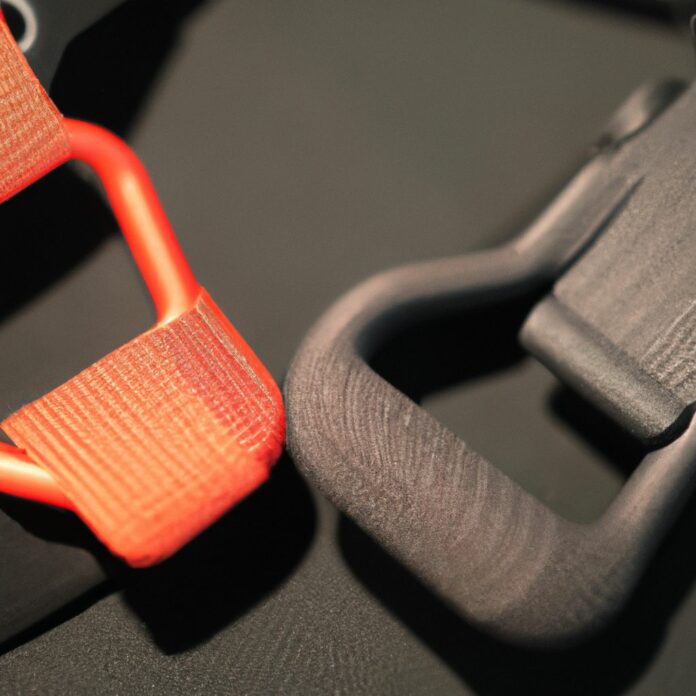When it comes to carrying a firearm, choosing the right holster is essential for comfort, safety, and functionality. Two popular options for holsters are the IWB (Inside the Waistband) and OWB (Outside the Waistband) holsters. Understanding the key differences between these two types of holsters is crucial in making an informed decision.
An IWB holster is designed to be worn inside the waistband, typically tucked inside your pants, providing a discreet and concealed carry option. These holsters are often secured to the belt or waistband using clips or loops.
On the other hand, an OWB holster is worn outside of the waistband, attached to the belt through loops or paddle attachments. OWB holsters offer quick and easy access to the firearm.
IWB holsters offer advantages such as better concealment, as the firearm is hidden inside the waistband. They also provide better retention and stability due to being securely fitted against the body. However, IWB holsters can be less comfortable, especially in warmer climates, and may require extra effort to access the firearm.
In contrast, OWB holsters offer a more comfortable carry, as they sit on the outside of the waistband, reducing the pressure on the body. They also allow for a quicker and more natural draw, making them popular for open carry and competition shooting. However, OWB holsters are less concealed, which may be a disadvantage in certain situations.
When considering the differences between IWB and OWB holsters, factors such as concealment, comfort, accessibility, draw speed, and overall safety should be taken into account.
Each type of holster has its pros and cons, and personal preference, body shape, and intended use should also be considered when selecting the right holster for your needs.
What are IWB and OWB Holsters?
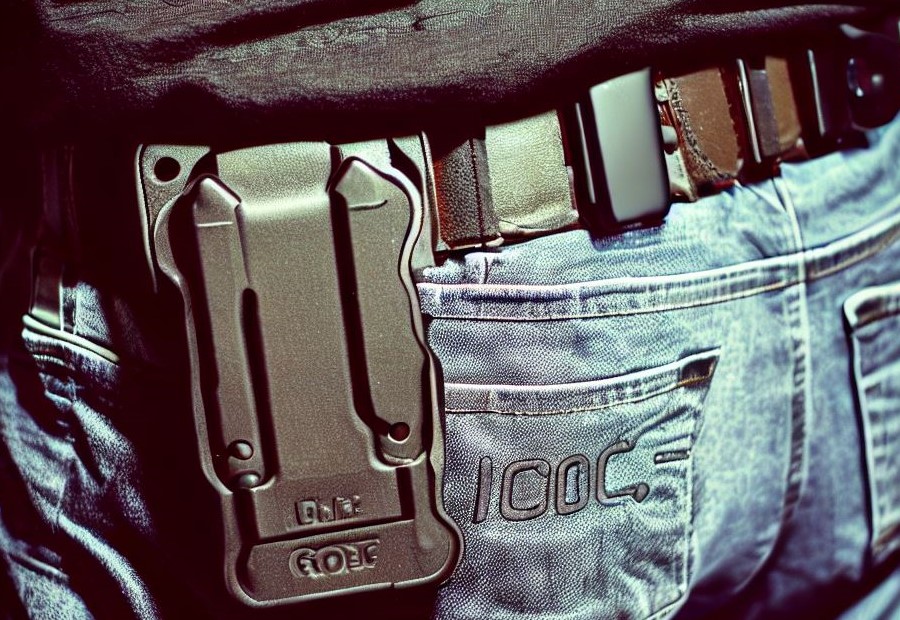
IWB and OWB holsters, also known as Inside the Waistband and Outside the Waistband holsters, respectively, are two types of holsters used for carrying firearms.
IWB holsters are worn inside the waistband of your pants, typically between the 3 o’clock and 5 o’clock positions for right-handed individuals. They offer greater concealment and a snug fit to the body, making them a popular choice for concealed carry. However, some people may find them less comfortable, especially when carrying a larger firearm.
On the other hand, OWB holsters are worn outside the waistband, usually on the hip. They provide better accessibility and comfort, as they are not nestled inside your pants. OWB holsters are commonly used for open carry or by individuals who prioritize comfort over concealment.
The main differences between IWB and OWB holsters can be summarized as follows:
– Concealment: IWB (Inside the Waistband) holsters are generally more concealed due to their position inside the waistband.
– Comfort: OWB (Outside the Waistband) holsters are often more comfortable since they are not inside your pants.
– Accessibility: OWB holsters allow for faster and easier access to the firearm.
– Draw Speed: OWB holsters generally enable a quicker draw compared to IWB holsters.
– Overall Safety: Both types of holsters are safe when used correctly, but IWB holsters provide an extra layer of concealment.
Ultimately, the choice between an IWB and OWB holster depends on your personal preferences and specific needs for carrying a handgun.
Overview of IWB Holsters
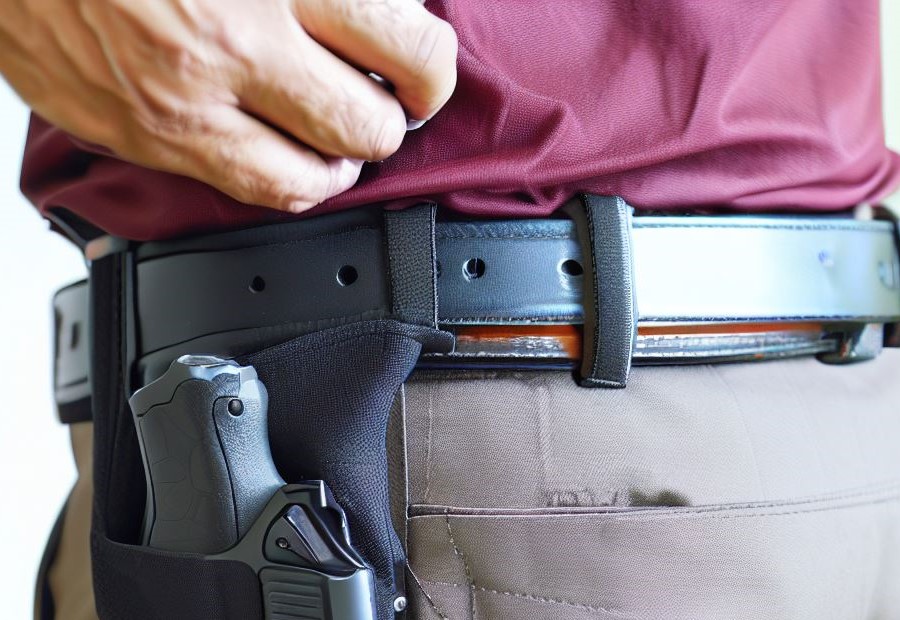
Here is an overview of IWB (Inside the Waistband) holsters:
- IWB holsters are designed to be worn inside the waistband of the wearer’s pants.
- They provide better concealment as the handgun is positioned inside the clothing, close to the body.
- IWB holsters come in various materials such as leather, Kydex, and nylon.
- They offer adjustable retention and can accommodate different types and sizes of handguns.
- IWB holsters are available in different carry positions, including appendix, strong-side hip, and small of the back.
- They are typically secured to the waistband using belt loops or clips.
- IWB holsters are favored by those who prioritize concealment and comfort.
The concept of IWB holsters dates back to the early 20th century when law enforcement officers needed a covert method of carrying their firearms. These holsters were initially simple leather pouches that attached to the wearer’s belt.
Over time, advancements in materials and design led to the development of more comfortable and versatile IWB holsters.
Today, they are a popular choice among concealed carry permit holders and individuals who value discreet firearm carry.
How Does IWB Holster Work?
The IWB (Inside the Waistband) holster provides a discreet and concealed method of carrying a firearm. Here is a rundown of how the IWB holster works:
- Insertion: To understand how does IWB holster work, the holster is inserted into the waistband of the pants, positioning the firearm against the body.
- Retention: The IWB holster securely holds the firearm in place, usually through tension, clips, or straps.
- Concealment: Part of comprehending how does IWB holster work is understanding that the firearm is concealed under clothing, with only a minimal portion visible.
- Accessibility: The IWB holster allows for easy access to the firearm, typically through a quick draw motion. This is an essential aspect of how does IWB holster work.
- Comfort: When considering how does IWB holster work, it’s important to note that the holster is designed to be comfortable for the wearer, with features such as padding or adjustable straps.
- Positioning: Depending on the wearer’s preference, the IWB holster can be positioned in different positions around the waistband, which is one of the ways how does IWB holster work.
Advantages of Using IWB Holsters
The advantages of using IWB holsters are numerous. IWB holsters are designed to be worn inside the waistband, allowing for easy concealment of your firearm. The snug fit of the holster against your body reduces the chances of printing or unintentional exposure.
Additionally, IWB holsters are known for their comfort, making them ideal for extended wear. The inside-the-waistband design evenly distributes the weight of the firearm, reducing strain on your hip or lower back.
Another advantage of IWB holsters is their accessibility. With the firearm positioned within arm’s reach, drawing it quickly and efficiently in self-defense situations is made easier.
Moreover, compared to OWB holsters, IWB holsters offer a faster concealed draw speed. The proximity of the gun to your body eliminates the need for excessive movement or adjustment when drawing.
In terms of safety, IWB holsters provide an extra layer of security. By securely holstering the firearm against your body, the risk of accidental discharge and unauthorized access is minimized. This ensures overall safety during concealed carry.
Disadvantages of Using IWB Holsters
One of the primary disadvantages of using IWB holsters is limited comfort. They can be uncomfortable to wear for long periods due to their bulkiness and weight, which can cause discomfort and irritation against the body.
Difficulty in concealment is another drawback of IWB holsters. While they are designed to be concealed, they can still create printing or bulges under clothing. This makes it challenging to maintain a low-profile and discreet carry, especially with tighter or lighter clothing.
Restricted accessibility is a concern with IWB holsters. Retrieving your firearm quickly can be more difficult compared to an OWB holster because the holster is positioned inside the waistband. You may need to lift clothing or navigate obstacles to access your weapon.
Another disadvantage of using IWB holsters is the impeded draw speed. The positioning of the holster can slow down the draw compared to an OWB holster. Unbuttoning or adjusting clothing and maneuvering around the holster can add precious seconds to your response time.
Using IWB holsters can also lead to potential sweating and moisture accumulation. The close contact between the body and the holster can cause increased sweating. If not properly maintained, this can negatively impact the condition of your firearm, potentially causing rust and deterioration.
Overview of OWB Holsters
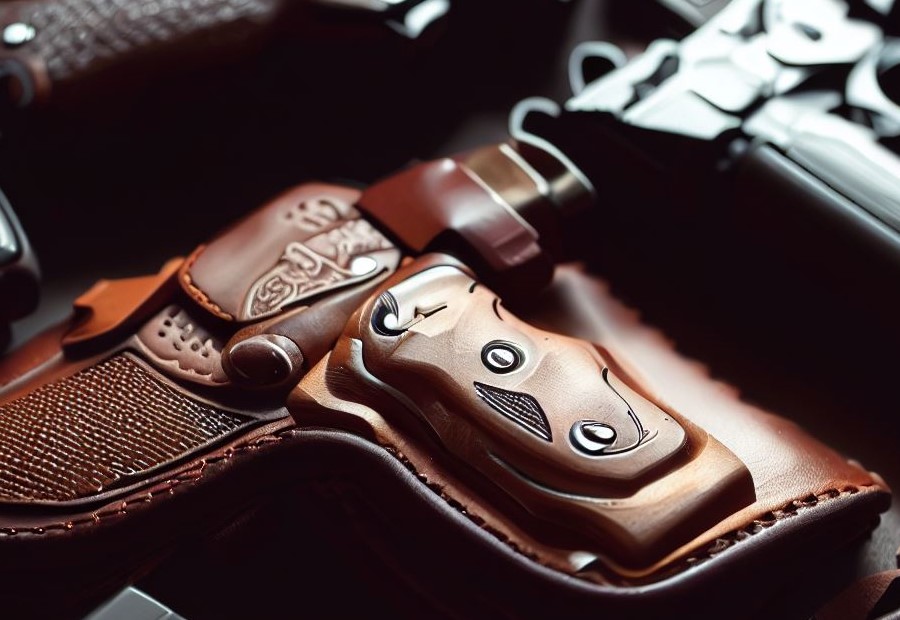
When it comes to OWB (Outside the Waistband) holsters, here is an overview of their features and benefits:
- Accessibility: OWB holsters are worn on the outside of the waistband, making it easier and quicker to draw your firearm when needed.
- Comfort: OWB holsters are generally more comfortable to wear for long periods since they don’t press against your body.
- Concealment: While not as concealable as IWB (Inside the Waistband) holsters, OWB options can still be concealed under an outer garment.
- Retention: OWB holsters typically offer excellent retention systems, ensuring that your firearm stays securely in place.
- Options: With OWB holsters, you have a wide range of styles, materials, and designs to choose from, allowing you to find the one that suits your needs and preferences.
Pro-tip: When selecting an OWB holster, consider the cant, or the angle at which the holster is worn. Experimenting with different cants can help you find the most comfortable and practical position for your firearm.
How Does OWB Holster Work?
The OWB holster works by attaching to a belt or waistband on the outside of the waist. It is worn openly and allows for easy access and quick draw of the firearm.
To secure the firearm, the OWB holster typically has a secure retention system, such as a thumb break or retention strap. This ensures that the firearm stays in place during movement and prevents accidental dislodging.
The OWB holster offers several advantages. Firstly, it provides a comfortable and secure way to carry a firearm. The holster is worn on the outside of the waist, allowing for better weight distribution and minimizing discomfort.
Secondly, the OWB holster offers easy accessibility. The firearm can be easily reached, making it ideal for quick response situations. Finally, the OWB holster allows for a faster draw speed compared to other holsters. This can be crucial in self-defense scenarios where every second counts.
However, there are also some disadvantages to using an OWB holster. It is less concealable compared to an IWB (inside the waistband) holster, as it is worn openly on the outside. This may not be suitable for those who prioritize discretion.
Additionally, the OWB holster may not be as secure during physical activities or when wearing loose clothing, as it is more exposed compared to an IWB holster.
When choosing the right holster for you, consider your specific needs and preferences. If concealment is a priority, an IWB holster may be a better option. However, if comfort, accessibility, and fast draw speed are important factors, the OWB holster may be the right choice for you.
Ultimately, it is important to find a holster that suits your individual needs and allows for safe and easy access to your firearm.
Advantages of Using OWB Holsters
- Accessibility is one of the main advantages. OWB holsters are typically easier to access compared to IWB holsters. They can be quickly and easily drawn from the waistband without the need to lift clothing or make any adjustments.
- Comfort is another advantage. OWB holsters are generally more comfortable to wear for extended periods of time. They do not press against the body or cause discomfort, allowing for better freedom of movement.
- OWB holsters offer various concealment options depending on your attire. They can be easily hidden under a jacket, coat, or loose-fitting clothing, making it easier to carry discreetly.
- Affordability is also an advantage of OWB holsters. Compared to IWB holsters, OWB holsters tend to be more affordable. They are often simpler in design and made from less material, resulting in a lower price range.
- One of the significant advantages of OWB holsters is their quick draw speed. Due to their position on the outside of the waistband, OWB holsters allow for a faster and more convenient draw. This can be advantageous in self-defense situations where every second counts.
Pro tip: When choosing an OWB holster, consider factors like retention, holster material, and the fit for your specific firearm to ensure optimal performance and safety.
Disadvantages of Using OWB Holsters
- One of the main disadvantages of using OWB holsters is limited concealment. Compared to IWB holsters, OWB holsters are more difficult to conceal and are typically worn outside the waistband, which makes them more visible under clothing.
- Another disadvantage is reduced comfort. OWB holsters can be less comfortable to wear, especially for individuals who prefer a more discreet and close-to-body fit. This is because OWB holsters tend to protrude further from the body, which can cause discomfort during prolonged wear.
- OWB holsters also have less accessibility compared to IWB holsters. They are generally worn in a fixed position, limiting accessibility and ease of drawing the firearm. This can be a drawback, especially in situations where quick and immediate access to the weapon is crucial.
- Furthermore, OWB holsters may result in a slower draw speed. Clearing clothing or cover garments is an additional step required with OWB holsters, which can delay drawing the weapon, especially in high-stress situations.
- Potential safety concerns are another disadvantage of OWB holsters. Positioned outside the waistband, they can increase the risk of accidental firearm discharges or unauthorized access to the weapon by others.
Differences Between IWB and OWB Holsters
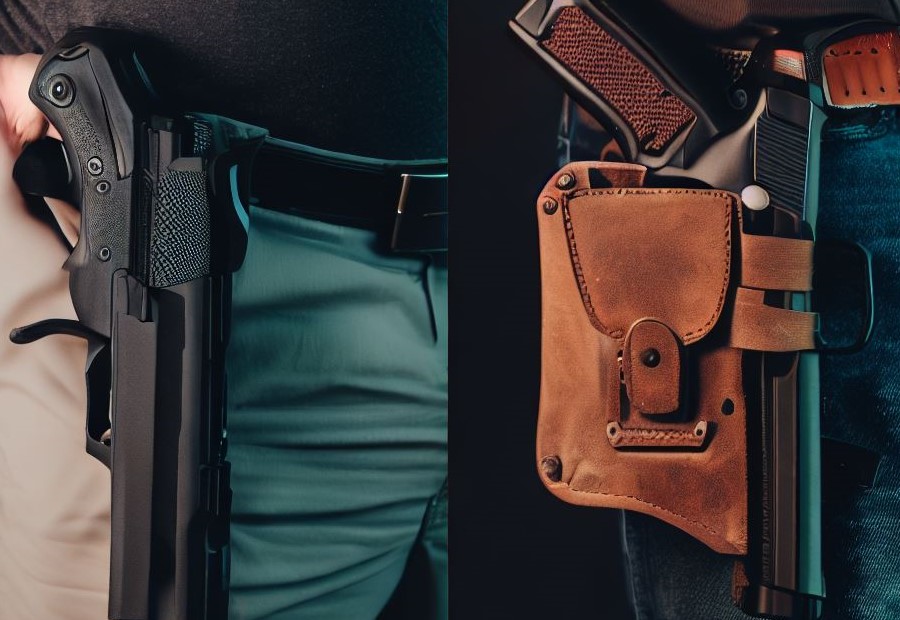
Discover the distinct characteristics that set IWB and OWB holsters apart. From concealment to comfort, accessibility to draw speed, and overall safety, we’ll explore these key factors that differentiate these two types of holsters.
So, whether you’re looking for a discreet concealed carry option or prioritizing quick and easy access, this section will shed light on what you need to know. Get ready to dive into the nuances of IWB and OWB holsters and find your perfect fit.
Concealment
Concealment is an important factor to consider when choosing between IWB and OWB holsters. IWB holsters, or Inside the Waistband holsters, are designed to be worn inside the waistband of your pants, which provides a high level of concealment.
The holster is tucked between your body and clothing, making it less visible to others. This allows you to discreetly carry your firearm without drawing attention.
On the other hand, OWB holsters, or Outside the Waistband holsters, are worn outside the waistband of your pants. While these holsters offer quick and easy access to your firearm, they are less concealed. The holster sits openly on your hip, making it more noticeable to others.
For maximum concealment, IWB holsters are the preferred choice. They keep your firearm tucked close to your body, minimizing the chance of printing or revealing your weapon. OWB holsters, although less concealed, may be more suitable for open carry situations or when concealment is not a priority.
When selecting a holster, it’s essential to consider your specific concealment needs. Factors such as clothing choices, body type, and personal preference should be taken into account. Ultimately, the key is to choose a holster that allows you to carry your firearm comfortably and discreetly, while adhering to local laws and regulations.
Comfort
When it comes to comfort, the choice between an IWB holster and an OWB holster can make all the difference. IWB holsters, or Inside-the-Waistband holsters, prioritize comfort by being designed to be worn inside the waistband of your pants.
This positioning allows the holster to be neatly tucked between your body and your clothing, resulting in a snug and secure fit. Consequently, this provides enhanced comfort as the holster is less likely to shift or move during your daily activities.
On the other hand, OWB holsters, or Outside-the-Waistband holsters, are worn on the outside of your waistband. While they may offer greater accessibility and easier draw, some individuals may find them less comfortable due to their bulkiness and potential for movement.
However, it’s important to note that with the right OWB holster and belt combination, comfort can still be achieved.
The comfort level of a holster can also be influenced by factors such as the material used, the size and weight of the firearm, and personal preference. Therefore, it’s crucial to try out different holsters, take into consideration your body type, and select the one that provides the utmost comfort for you.
Accessibility
When considering the sub-topic of accessibility in the context of IWB and OWB holsters, it is important to understand the differences between the two and how they impact one’s ability to access their firearm quickly and efficiently.
- IWB Holsters: With an Inside the Waistband (IWB) holster, the firearm is positioned inside the waistband and tucked against the body. This can sometimes make it slightly more challenging to access the firearm quickly, as it requires reaching underneath clothing and potentially readjusting garments. However, IWB holsters can still provide relatively easy accessibility with proper practice and training.
- OWB Holsters: On the other hand, Outside the Waistband (OWB) holsters are worn outside the waistband, typically on the hip. OWB holsters offer more straightforward accessibility, as the firearm is not obstructed by clothing or the body. Drawing the firearm from an OWB holster is generally quicker and more intuitive.
Ultimately, the choice between IWB and OWB holsters should be based on individual needs, comfort, and the level of accessibility required in different situations. It is recommended to try different holsters and practice drawing the firearm to determine which option provides the desired level of accessibility while ensuring safety and proficiency.
Draw Speed
The draw speed is a crucial factor to consider when choosing between IWB and OWB holsters. Here are some key points to understand about draw speed:
- IWB Holsters: Drawing a firearm from an inside-the-waistband (IWB) holster generally requires more time compared to an outside-the-waistband (OWB) holster. This is because the IWB holster is typically concealed under clothing, which can impede quick access.
- OWB Holsters: With an outside-the-waistband (OWB) holster, the draw speed is generally faster as the holster is worn openly on the outside of the waistband. It allows for a more direct and unencumbered draw.
- Clothing Considerations: The clothing you wear can also impact draw speed. In general, loose-fitting clothing may be more conducive to a quicker draw from an IWB holster, while OWB holsters may be more suitable for situations where concealment is not a priority.
- Training and Practice: Regardless of the type of holster you choose, regular training and practice are vital to improving your draw speed. Familiarity and muscle memory are crucial in developing a fast and efficient draw technique.
When selecting a holster, understanding the draw speed and how it aligns with your needs and preferences is essential. Consider your intended use, comfort, and training level to make an informed decision.
Overall Safety
The overall safety of a holster is crucial in ensuring that your firearm stays securely in place. Both IWB and OWB holsters should have a reliable retention system that holds the gun tightly to prevent accidental dislodging or unauthorized access.
The holster should fully cover the trigger guard of the firearm to prevent any unintended trigger engagement. This feature enhances overall safety by reducing the risk of accidental discharge.
A key aspect of overall safety is the ability to adjust the holster to fit your body type and clothing preferences. Proper adjustment ensures a snug and secure fit, minimizing the chances of the firearm shifting or moving unexpectedly.
The holster material should be durable and able to withstand regular use. It should also be non-abrasive to prevent any damage to the firearm’s finish. High-quality materials contribute to the overall safety and longevity of the holster.
The holster should fully cover the trigger area and prevent any objects or clothing from inadvertently accessing or pressing the trigger. This feature minimizes the risk of accidental discharge and ensures overall safety during holstering and drawing.
The holster should provide a smooth and consistent draw, allowing for quick access to the firearm when needed. A reliable drawing mechanism enhances overall safety by minimizing the risk of fumbling or mishandling during high-stress situations.
Choosing the Right Holster for You
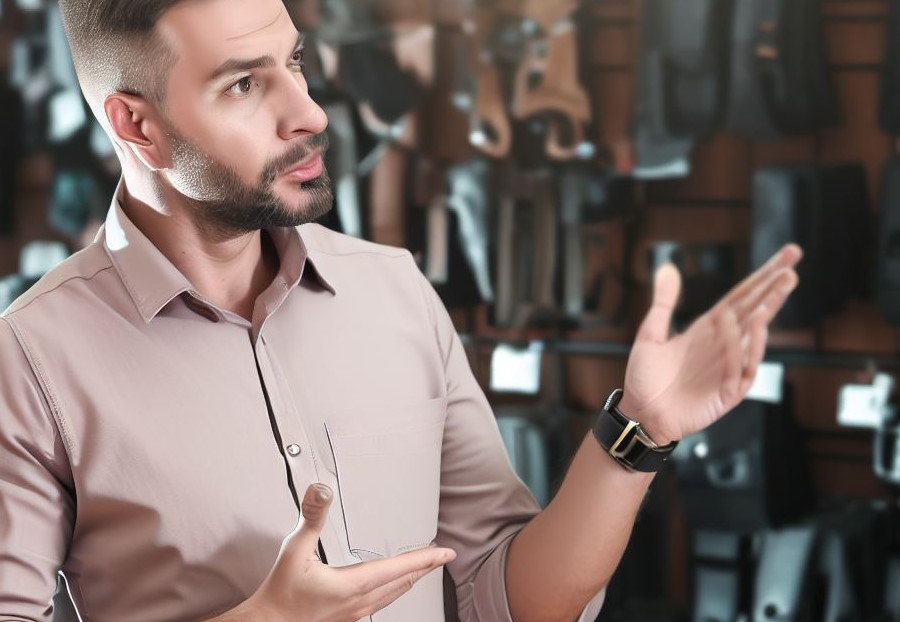
When it comes to finding the perfect holster, understanding the differences is key. In this section, we’ll dive into the ins and outs of choosing the right holster for you. We’ll explore the specific considerations for selecting both the IWB holsters and the OWB holsters, giving you all the information you need to make an informed decision.
So, whether you’re leaning towards a concealed carry or prefer the convenience of an outside the waistband option, we’ve got you covered!
Considerations for Selecting IWB Holsters
When selecting IWB holsters, there are several important considerations to keep in mind:
- Comfort: It is crucial to choose an IWB holster that offers comfort during extended periods of wear. Look for holsters with features like padded backings or adjustable clips to enhance comfort.
- Concealment: The level of concealment provided by an IWB holster is another important factor to consider. Opt for models that are designed to sit low and close to the body, minimizing printing and ensuring effective firearm concealment.
- Retention: Proper retention is essential when selecting an IWB holster. Look for holsters that offer adjustable retention screws or retention devices to securely hold your firearm in place.
- Accessibility: Ensure that the IWB holster allows for easy and quick access to your firearm. Look for models that enable a full grip when drawing and offer smooth and reliable draw strokes.
- Compatibility: It is crucial to check whether the IWB holster is compatible with your specific firearm make and model. Ensuring a proper fit guarantees both the safety and functionality of the holster.
- Material: Consider the material used in the construction of the IWB holster. Common options include leather, Kydex, or hybrid materials. Each material has its own advantages and disadvantages, so choose based on your personal preferences and needs.
Considerations for Selecting OWB Holsters
When selecting OWB holsters, there are a few key considerations to keep in mind:
- Retention: It is important to choose an OWB holster that has a reliable retention system in order to securely hold your firearm in place. Look for options that offer adjustable retention so you can customize it to your liking.
- Comfort: Look for a holster with a design that prioritizes comfort and won’t cause any discomfort or digging into your skin, even when worn for long periods. Features like padding or adjustable cant can provide additional comfort.
- Concealment: While OWB holsters are generally less concealable than IWB holsters, there are some options available with better concealment features. Look for holsters that minimize printing and have a slim profile to effectively conceal your firearm.
- Ease of access: It is crucial that the OWB holster allows for quick and easy access to your firearm when needed. Opt for holsters with adjustable cant or a grip-enhancing design that enables a smooth draw.
- Durability: Choose a holster made from high-quality materials that are built to withstand daily use without losing their shape or functionality. Look for options with reinforced construction and durable hardware.
Pro-tip: Before purchasing an OWB holster, consider your specific needs and circumstances. Factors such as dress style, body type, and the activities you engage in will impact the suitability of different holster options.
Frequently Asked Questions
What is the difference between IWB and OWB holsters?
IWB (inside-the-waistband) and OWB (outside-the-waistband) holsters refer to the placement of the holster when carrying a concealed firearm. IWB holsters are worn inside the waistband of the pants, while OWB holsters are worn on the outside of the pants.
Which type of holster is more comfortable?
Comfort is subjective and can vary between individuals. Generally, OWB holsters are considered more comfortable because they do not rub against the skin like IWB holsters. However, with the right holster and adjustments, IWB holsters can also be comfortable for many people.
Which type of holster offers better accessibility?
OWB holsters provide easier access to the gun since they are worn on the outside of the pants. However, with practice, an IWB holster can also offer quick and easy access to the firearm.
Which type of holster is better for concealment?
IWB holsters are generally better for concealment as they can completely hide the firearm, with only the grip visible above the waistband. OWB holsters can still be concealed with appropriate clothing, but they require a cover garment like a vest or jacket.
Can OWB holsters be used for everyday carry?
Yes, OWB holsters can be used for everyday carry, but they are less common in concealed carry situations. They are more popular in open carry environments. For everyday concealed carry, IWB holsters are generally a better choice.
What factors should I consider when choosing a holster?
When choosing a holster, it is important to consider factors such as fit, comfort, durability, and overall design. Make sure the holster securely holds the gun, covers the trigger and trigger guard completely, and allows for one-handed re-holstering. Investing in a good, concealed carry belt is also essential for proper holster function.

